 advertisements advertisements
|

|
STS-1 artifacts, 25 years later (Official Flight Kit)
April 12, 2006 — Twenty-five years ago today, the Space Shuttle Columbia launched into history as the world's first winged orbital vehicle designed to be reusable. The STS-1 mission, with its two-man crew of John Young and Robert Crippen, introduced a new chapter for U.S. manned space flight efforts.
Whereas past and future milestone missions would trigger attempts to collect and preserve the artifacts created as a result, the nature of the Space Shuttle would greatly limit that from happening for STS-1.
Unlike the Apollo Command Module that shared its name, orbiter Columbia would not be destined for a museum. The STS-1 spacecraft would fly again seven months after its first flight, proving its reusability. However, before it could launch, OV-102 (as Columbia was also referred, for Orbiter Vehicle-102) needed some repair.
During its maiden space flight, Columbia lost 16 of its heat shield tiles and a further 148 had been damaged. The tiles and other components removed post-flight became one of the first artifacts to be saved of STS-1. Some of the white and black thermal barriers were kept intact and presented to VIPs such as Flight Director Eugene Kranz. Still others were sliced apart into small squares and encased in Lucite for distribution to team members as "Space Transportation System Mementos".
Similar presentations are known to have occurred for other replaced parts, including samples taken from Columbia's wing leading edge and landing gear tires. An unspecified amount of flown metal was mixed with ground-based alloy to mint commemorative medallions that NASA's Manned Flight Awareness Office then gifted to the employees and contractors responsible for the STS-1 mission's success.
Columbia itself would fly a total of 28 crews to orbit, each time taking with it much of the original vehicle that Young and Crippen flew on STS-1. In 2001, the orbiter's original switch-controlled cockpit was replaced with a new "glass" version. During the same 17-month refurbishment, 1,000 pounds of wiring and equipment used to monitor OV-102's early missions were removed and believed to have been scrapped (as with the majority of parts removed after each of Columbia's 27 successful flights).
Then in February 2003, while returning from its 28th flight to space, Columbia and its STS-107 crew of seven were lost during reentry. In the weeks and months that followed the break-up over Texas, nearly 84,000 pieces were found and identified. After the subsequent investigation finished analyzing the debris, the components were moved to the 16th floor of the building where Columbia was readied for launch, where they remain today. The floor is closed to all but researchers and a small group of employees. NASA has also allowed key parts to be sent out for scientific and academic study.
Neither of the STS-1 crew members see a need or desire for parts of Columbia collected after the accident to be put on public display.
"I don't know why anyone would want to see old burned up parts," said Young in an interview with collectSPACE. "She was a great vehicle and I am just sorry it happened."
"I don't think it is appropriate to put her in that form on a public display," said Crippen in a separate collectSPACE interview. "She was a proud ship, one that I'm honored to have flown. Putting out the pieces would not have been the right thing to do."
Though Columbia is no longer flying, parts of the STS-1 launch vehicle continue to lift other orbiters skyward. The white-painted External Tank was purposely left to reenter and break apart after its use (as is the case with all tanks) but the twin solid rocket boosters — the first used for a manned space flight — were recovered and reused. Most recently, the uppermost cylinder of the left booster that launched the return to flight mission after Columbia's loss, STS-114, could be traced back to the April 1981 mission.
Beyond Columbia and its components as STS-1 artifacts, are the crew's equipment and personal items.
Both Young and Crippen donned for launch and landing modified pressure suits originally designed for the U.S. Air Force's SR-71 high-altitude reconnaissance aircraft. The orange-brown outfit that Young wore is now on display at Space Center Houston, the public visitor center for NASA Johnson Space Center.
The similar suit that Crippen wore is believed to have been returned to the Air Force. Its present location is unknown. Crippen's STS-1 blue T-38 flight suit is among the artifacts held and displayed by the U.S. Astronaut Hall of Fame in Titusville, Florida.
Young and Crippen both carried a Personal Preference Kit (PPK) that was limited to a combined total 2.5 pounds of personal items they flew for family members and friends. They each carried 20 items that included silver and gold medallions minted by The Robbins Company of Attleboro, Massachusetts (19 for Young, 14 for Crippen); a flag (by Crippen); rings (both Crippen for ascent flight director Neil Hutchinson, and Young "for Susy," his second wife); and wings (by Crippen, his own and for fellow USAF Manned Orbiting Laboratory-then-NASA astronaut Bob Overmyer).
Most, if not all of the mementos the crew carried however, have since been given away.
"I don't think I have any, I gave away everything that I flew up. The intent at the time was taking up things for people that were special to me and I gave those to them when we got back down," said Crippen.
"I probably carried some flags and stuff," recounted Young. "If I do [have them], they're probably sitting in some safety deposit box somewhere."
STS-1 also carried an Official Flight Kit (OFK) containing presentation items that NASA, the crew and others would distribute post-flight. OFKs have flown on all subsequent shuttle missions and can be traced back to Apollo flights.
Notable among the STS-1 OFK contents (presented in its entirety below) were 10,000 small U.S. flags, which were later given to employees and VIPs much in the same way as the tiles and medallions mentioned earlier. These flags represent the most accessible of STS-1's artifacts today, with many museums and private collections including the nylon banners as their representative of the first mission. |
|
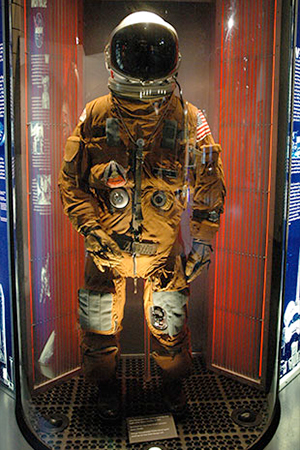
STS-1 commander John Young's pressure suit as seen on display at Space Center Houston, the visitor center for the Johnson Space Center in Texas. The location of STS-1 pilot Bob Crippen's similar suit is unknown. (collectSPACE)
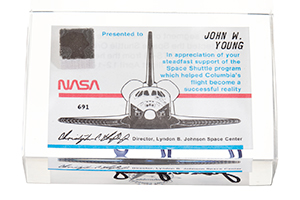
An example of a Space Transportation System Memento that was gifted to STS-1 team members. Each acrylic block holds a piece of a damaged heat shield tile removed off Columbia. (Heritage)
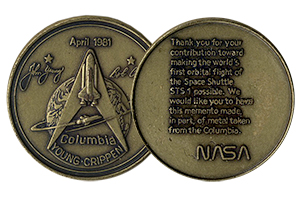
NASA's Manned Flight Office distributed medallions, such as this one, that were imprinted on the reverse: We would like you to have this memento made, in part, of metal taken from the Columbia. (cS)
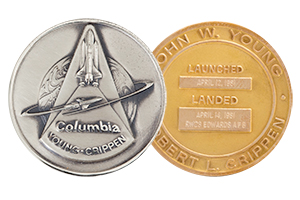
Examples of silver and gold STS-1 Robbins medallions. (Heritage)
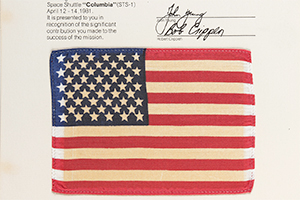
STS-1's Official Flight Kit carried 10,000 small United States flags, which were presented by NASA to employees and VIPs. (Heritage) |
The STS-1 Official Flight Kit Manifest
The following is the STS-1 Official Flight Kit manifest, as it is archived by NASA on February 4, 1981.
|
No.
|
|
Description
|
|
Recipient/Remarks
|
|
|
|
|
|
|
To be awarded by the Administrator to hang in Washington, D.C. at perhaps the Air and Space Museum or the Capital
|
|
|
|
|
|
|
|
|
|
|
|
10,000 small U.S. flags
(4" x 6" size)
|
|
To be distributed in a manner similar to what was done on ALT [Approach and Landing Test]
|
|
|
|
|
1,000 medium size U.S. flags
(8" x 12")
|
|
To be used as suitable mementos
|
|
|
|
|
|
|
To be used as suitable mementos
|
|
|
|
|
Five sets of United Nations Members Flags (4"x6")
|
|
To be used as suitable mementos
|
|
|
|
|
Five sets of state and territorial flags (4"x6")
|
|
To be used as suitable mementos
|
|
|
|
|
Standard Flag of the City of Houston
|
|
To be awarded as appropriate
|
|
|
|
|
|
|
To be awarded as appropriate
|
|
|
|
|
Standard Flag of Georgia Institute of Technology
|
|
To be awarded by John Young
|
|
|
|
|
Standard Flag of Montgomery County, Texas
|
|
To be awarded by Robert Crippen
|
|
|
|
|
Standard Flag of the University of Texas
|
|
To be awarded by Robert Crippen
|
|
|
|
|
Standard Flag of the City of San Francisco
|
|
To be awarded by John Young
|
|
|
|
|
Standard Flag of the City of Orlando, Florida
|
|
To be awarded by John Young
|
|
|
|
|
National Aeronautics Association (NAA) Flight Certificate
|
|
To be awarded as appropriate
|
|
|
Items 16 through 28 will be awarded to participating astronauts in the STS-1 flight.
|
|
|
|
|
|
|
|
|
|
|
|
|
|
|
|
|
|
|
|
|
|
|
|
|
|
|
|
|
|
|
|
|
|
|
|
|
|
|
|
|
|
|
|
|
|
|
|
|
|
|
|
|
|
|
|
|
|
|
|
|
|
|
|
|
|
|
|
|
|
Items 29 through 112 will be awarded to the following astronauts.
|
|
|
|
|
|
|
|
|
|
|
|
|
|
|
|
|
|
|
|
|
|
|
|
|
|
|
|
|
|
|
|
|
|
|
|
|
|
|
|
|
|
|
|
|
|
|
|
|
|
|
|
|
|
|
|
|
|
|
|
|
|
|
|
|
|
|
|
|
|
|
|
|
|
|
|
|
|
|
|
|
|
|
|
|
|
|
|
|
|
|
|
|
|
|
|
|
|
|
|
|
|
|
|
|
|
|
|
|
|
|
|
|
|
|
|
|
|
|
|
|
|
|
|
|
|
|
|
|
|
|
|
|
|
|
|
|
|
|
|
|
|
|
|
|
|
|
|
|
|
|
|
|
|
|
|
|
|
|
|
|
|
|
|
|
|
|
|
|
|
|
|
|
|
|
|
|
|
|
|
|
|
|
|
|
|
|
|
|
|
|
|
|
|
|
|
|
|
|
|
|
|
|
|
|
|
|
|
|
|
|
|
|
|
|
|
|
|
|
|
|
|
|
|
|
|
|
|
|
|
|
|
|
|
|
|
|
|
|
|
|
|
|
|
|
|
|
|
|
|
|
|
|
|
|
|
|
|
|
|
|
|
|
|
|
|
|
|
|
|
|
|
|
|
|
|
|
|
|
|
|
|
|
|
|
|
|
|
|
|
|
|
|
|
|
|
|
|
|
|
|
|
|
|
|
|
|
|
|
|
|
|
|
|
|
|
|
|
|
|
|
|
|
|
|
|
|
|
|
|
|
|
|
|
|
|
|
|
|
|
|
|
|
|
|
|
|
|
|
|
|
|
|
|
|
|
|
|
|
|
|
|
|
|
|
|
|
|
|
|
|
|
|
|
|
|
|
|
|
|
|
|
|
|
|
|
|
|
|
|
|
|
|
|
|
|
|
|
|
|
|
|
|
|
|
|
|
|
|
|
|
|
|
|
|
|
|
|
|
|
|
|
|
|
|
Items 113 through 126 are under review with General Simkaitis at this time.
|
|
|
|
|
Standard Presidential Flag
|
|
To be awarded as appropriate
|
|
|
|
|
Standard Vice Presidential Flag
|
|
To be awarded as appropriate
|
|
|
|
|
Standard Secretary of Defense Flag
|
|
To be awarded as appropriate
|
|
|
|
|
Standard Secretary of the Air Force Flag
|
|
To be awarded as appropriate
|
|
|
|
|
Standard Secretary of the Navy Flag
|
|
To be awarded as appropriate
|
|
|
|
|
Standard Secretary of the Army Flag
|
|
To be awarded as appropriate
|
|
|
|
|
Standard Marine Corps Flag
|
|
To be awarded as appropriate
|
|
|
|
|
Standard Joint Chiefs of Staff Flag
|
|
To be awarded as appropriate
|
|
|
|
|
Standard Chief of Naval Operations Flag
|
|
To be awarded as appropriate
|
|
|
|
|
Standard Chief of Staff of the Air Force Flag
|
|
To be awarded as appropriate
|
|
|
|
|
Standard U.S. Air Force Academy Flag
|
|
To be awarded as appropriate
|
|
|
|
|
Standard U.S. Naval Academy Flag
|
|
To be awarded as appropriate
|
|
|
|
|
|
|
To be awarded as appropriate
|
|
|
|
|
Standard NATO (or AGARD) Flag
|
|
To be awarded as appropriate
|
|
|
Items 127 through 133 will be awarded to the following astronauts.
|
|
|
|
|
|
|
|
|
|
|
|
|
|
|
|
|
|
|
|
|
|
|
|
|
|
|
|
|
|
|
|
|
|
|
|
|
|
|
|

© collectSPACE. All rights reserved.
|
|

|

|
